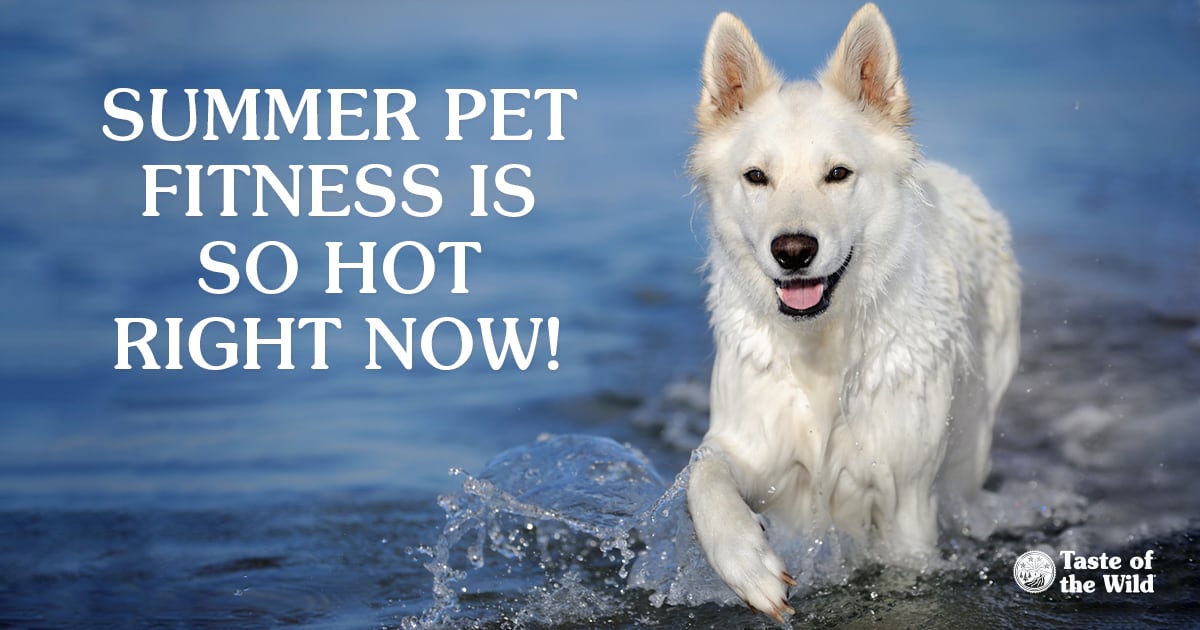
Most dog owners walk their dogs regularly no matter what the season. But with spring and summer weather, many owners and their dogs venture outdoors for more active pursuits such as running, hiking and swimming. We know how to get ourselves ready for summertime adventures, but what about our dogs?
Family dogs — not just working and performance dogs — need training to get into shape, too.
“Like us, many dogs cannot jump right from the couch into strenuous or high-intensity activities,” explains Melissa Brookshire, DVM, with North River Enterprises in Lee’s Summit, Missouri. “You need to ease your dog into it, just as you do yourself. While some dogs are designed for high levels of activity, other dogs — including older dogs, overweight dogs or those with health issues such as arthritis or heart disease — will need to start gradually.”
Slow, gradual approach is key to fitness success
After a winter lull, you and your dog will likely follow similar training programs so that you’re both ready for summer heat and higher activity levels.
- Schedule an annual physical exam: Just as people are advised to consult their physician before starting fitness programs, dog owners should talk with their veterinarian about their dog’s readiness for increased exercise. A dog’s age, breed and general health influence the type and amount of exercise it needs. Your veterinarian will check your dog for bone, joint, heart, lung and other health problems that could be aggravated by increased activity.
- Assess your dog’s dietary needs: Proper nutrition is just as important as appropriate exercise when getting your dog fit for increased summer activities. In fact, dogs should be healthy inside before starting a conditioning program.
“Feeding a high-quality, highly digestible diet is sufficient for most dogs that will be more active during summer months,” Dr. Brookshire says. “If a dog is already eating a high-quality dog food and will only be running 2 miles or so daily, no change in diet should be necessary.” - Start with short, low-intensity workouts: If your dog isn’t in good shape or if they have been sedentary all winter, start slow and gradually increase the distance, time and intensity of exercise. This approach will safely strengthen your dog’s muscles, increase their aerobic capacity and help them lose weight while allowing the paw pads to adapt to outdoor surfaces. Remember, if you feel stiff and sore after jumping into an aggressive workout after being sedentary all winter, your dog will likely feel sore, too.
- Pay attention to your dog during exercise: Dogs have many subtle ways of telling us they’re tired, hot or uncomfortable. Your dog may lag behind, stop or sit down during activities to show they are getting tired and needs to rest. While dogs naturally pant when exercising, if you think your dog is panting too much, chances are they need a break or may be overheating.
According to Small Animal Clinical Nutrition, 75 to 80 percent of the energy used by a dog’s muscles during exercise is changed into heat, which must be removed from the body. Dogs release most of this heat by panting. During very intense exercise or activities in hot weather, the heat produced exceeds the ability of the respiratory tract (panting) to lose heat, increasing body temperature. While dogs can tolerate a few degrees of increased body temperature for a short period, prolonged heat stress can be dangerous. That’s why it’s so important to closely monitor your dog during summertime activities.
Consider Taste of the Wild for your active dog
When it comes to your dog’s food, there are some key factors to keep in mind. Like our food, dog food must contain specific levels of calories, protein, fat, carbohydrates, vitamins and minerals to meet a dog’s nutritional needs. Of course, water is considered the most important nutrient, which is why providing free access to fresh water is vital to your dog’s health.
High-quality dog foods should have a real animal protein — such as bison, venison or duck — listed as the first ingredient. All Taste of the Wild dog recipes have animal protein as the first ingredient. High Prairie Canine Recipe with Roasted Bison & Roasted Venison, Wetlands Canine Recipe with Roasted Fowl and Appalachian Valley Small Breed Canine Recipe with Venison & Garbanzo Beans can provide the nutrition your active dog needs.
As always, it’s important to read the labels carefully when selecting a food for your dog. You’ll also want to consult with your veterinarian about the appropriate amount of feed.
Do you have a favorite summer activity that you do with your dog? If so, head over to our Facebook page and let us know!
RELATED: What You Need to Know to Get Your Puppies Through Their First Summer
The information in this blog has been developed with our veterinarian and is designed to help educate pet parents. If you have questions or concerns about your pet's health or nutrition, please talk with your veterinarian.
